The Saint Bernard is a true giant breed representative that reaches up to 30 inches in height, and weighs over a whopping 190 pounds!
This large dog is extremely agile and always alert. After all, the St. Bernard is bred to be the best rescue dog in the world.
But, how big does a Saint Bernard get?
The answer to this question lies in a simple Saint Bernard growth chart, which aims to show an estimated Saint Bernard puppy growth.
Due to a sudden puppy spurt in the St. Bernard’s growth, many owners wonder, “How fast do Saint Bernard puppies grow?”
Well, they grow quite fast — your St. Bernard puppy is a large breed of dog, and you will notice huge changes in its growth during the first six months.
To help you estimate your Saint Bernard’s size during its lifetime, we have come up with this Saint Bernard growth chart.
Bear in mind that this isn’t your average Saint Bernard growth chart — in this article, we are going to talk about the whole process of a Saint Bernard’s growth.
So, we will follow the Saint Bernard’s weight and height from puppyhood to adulthood. And, that’s not all — we will also cover the most important factors that affect the Saint Bernard puppy’s growth.
Let’s see how a small St. Bernard puppy makes its way to becoming a giant, fluffy dog that’s full of love and affection!
Saint Bernard Puppy Growth Chart

Saint Bernard puppies are some of the cutest little creatures you will see! They are soft, goofy, and extremely loving. But, are Saint Bernard puppies really “little”?
Well, it’s safe to say that a four-week-old Saint Bernard puppy is as big as an adult toy dog.
Let’s take a closer look at the Saint Bernard puppy’s development!
Saint Bernard Weight Chart – An Overview
For starters, let’s take a look at the Saint Bernard’s weight chart. It will be easier for you to follow a St. Bernard puppy’s growth through this simple table.
Keep in mind that growth charts only estimate a dog’s weight and height. Each dog is unique and might not fall under numerical values.
[table id=371 /]
You might notice huge gaps between the third and sixth month of age.
This is because during this period, Saint Bernard puppies experience rapid physical growth in both weight and height.
In case you are wondering, “how tall is a Saint Bernard?”, keep reading to find out!
Male Saint Bernard Puppy Weight Chart
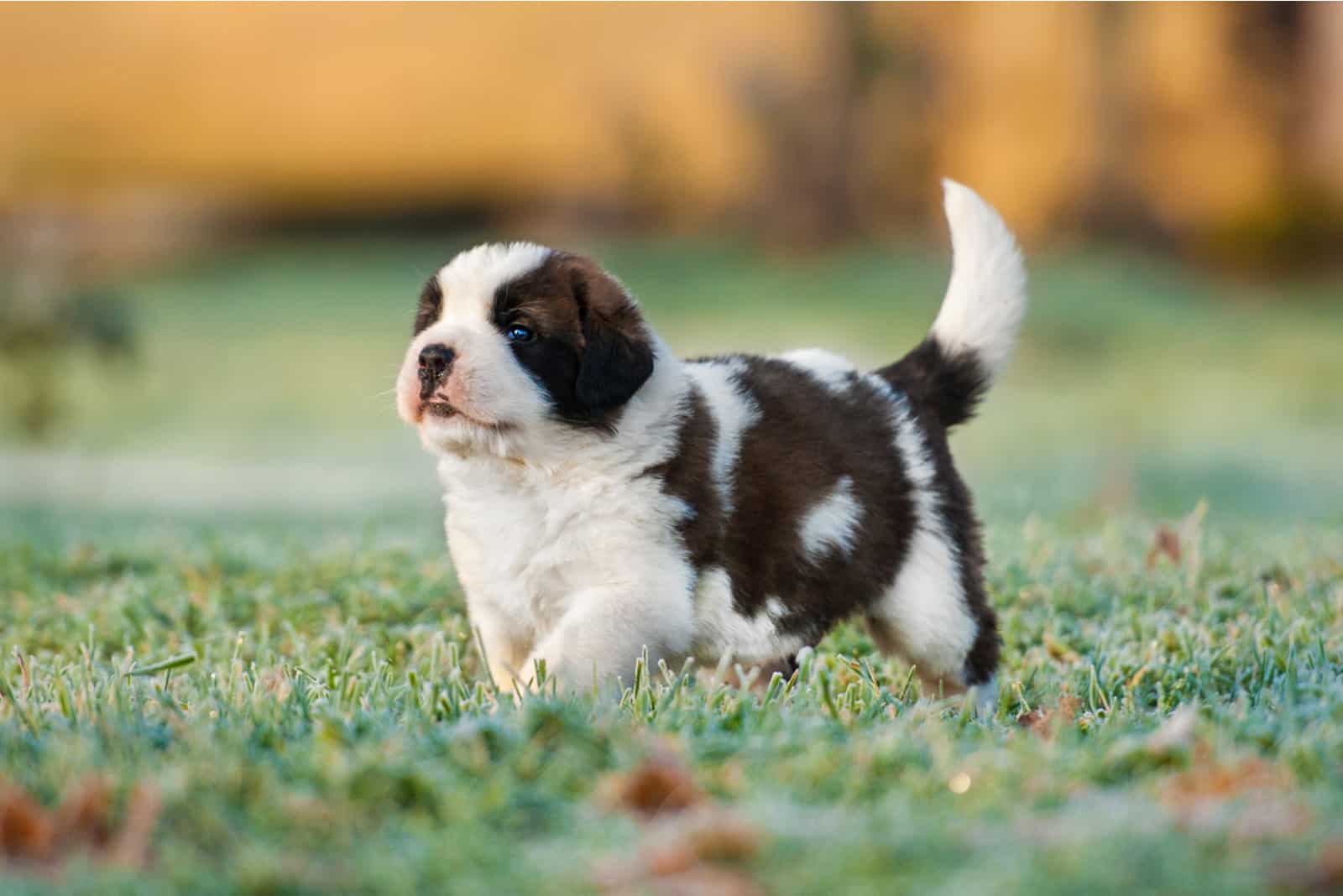
From birth, a male Saint Bernard puppy will be bigger than his sister. During the male puppy’s development stage, it will keep outgrowing the female puppies.
Male Saint Bernard puppies are the mischievous ones in the litter. This is usually the case with every male puppy. Either they fight with littermates, or just wander away on an adventure.
At four weeks of age, a male Saint Bernard puppy weighs from 22 to 25 pounds. As time goes by, its appetite gets bigger and he gets larger in size!
When it reaches three months of age, the male Saint Bernard puppy weighs around 55 to 60 pounds.
The male Saint Bernard puppy rapidly grows until 12 months of age, when it weighs from 160 to 165 pounds. Now, he doesn’t stop growing at this period – the growth rate just slows down a bit.
So, instead of gaining 25 pounds per month, after six months of age, a male St. Bernard puppy gains around 20 pounds in every forthcoming month.
Female Saint Bernard Puppy Weight Chart
Female Saint Bernard puppies are significantly lighter than their male counterparts. If you notice smaller puppies in the St. Bernard litter, chances are that they are females.
Female Saint Bernard dogs also have different physical features than males. They appear more “feminine”. Their head is smaller and less bulky, and some inherit a longer, shinier coat.
So, at four weeks of age, female Saint Bernard puppies weigh less than 23 pounds. The female puppy will follow her brothers, but won’t be larger in size.
Weighing from 48 to 50 pounds at three months of age, female Saint Bernard puppies go through the puppy spurt period.
Reaching six months of age, females weigh between 88 and 95 pounds!
Female Saint Bernard puppies show different behavioral patterns than their brothers. They are more laid-back and much more attentive and obedient.
During the heat period, adult female Saint Bernard dogs are less likely to wander away from their home.
Saint Bernard Puppy Growth Rate

Saint Bernard puppies grow SO fast! And, I mean extremely fast. You can almost turn around and your Saint Bernard puppy will be four inches bigger than it was just a few seconds ago.
This is the case with all giant and large breeds. We see an intense growth spurt in giant breeds like Great Danes, Newfoundlands, Leonbergers, and Bernese Mountain Dogs.
Large dog breeds like Labrador Retrievers, German Shepherds, Golden Retrievers, and Standard Poodles show just a bit slower growth rate than giant breeds.
On the other hand, medium-sized dogs like Cocker Spaniels, Border Collies, Siberian Huskies, and Beagles stand somewhere in the “golden middle”. Their growth rate is moderate.
But, small dogs like Shih Tzus, French Bulldogs, Yorkshire Terriers, and Maltese tend to grow slower. Even when they reach adult size, they still look as if they are in the process of growing up.
Although large dogs grow faster, they reach their full size slower. This phenomenon in the canine world might be due to the fact that larger dogs have slower metabolisms.
It is also believed that their big bones require more time to develop. Another thing that I want to mention that makes me really sad is that large and giant dog breeds age faster.
The Stages Of Saint Bernard Puppyhood

Even though it is difficult to tell when exactly these big dogs start becoming so big, their growth chart can be estimated.
From the first day of its life, and all the way to its adult size, the St. Bernard puppy is weighed and measured.
That’s how growth and weight charts are made. But, to make a Saint Bernard puppy growth chart, we first must know what happens during its growing-up journey.
Stage 1: The Arrival Of Mini Giants
During the very first seconds of their lives, Saint Bernard puppies weigh between 1.2 and 1.5 pounds.
Their eyes are closed, and they won’t open until ten to twelve days of life. They wiggle around and start nursing. With a proper diet, these puppies start developing very fast.
Stage 2: Socialization With Littermates
Around three weeks of age, St. Bernard puppies become more active. They are still dependent on Mom, but they sniff around and interact with their brothers and sisters.
So, at three weeks of age, a St. Bernard puppy weighs around ten pounds. It’s good to mention that an adult toy Poodle weighs less than a three-week-old St. Bernard puppy!
This stage is very important for every puppy. Early socialization is the fundamental step in raising a well-mannered dog.
Stage 3: Reaching The First Month
The first month of age is when you get to see the beginning of the St. Bernard’s puppy spurt. What happens during the first month is crucial to the puppy’s physical and mental development.
When a St. Bernard puppy turns one month old, it can weigh between 12 and 25 pounds. This, of course, depends on whether it’s a male or a female.
So, for a one-month-old puppy, this is quite heavy!
Stage 4: Rapid Growth
During the third and fourth month of age, St. Bernard puppies grow like crazy! Weighing from 50 to 75 pounds, these puppies become heavier each day.
Medium-sized dogs like Border Collies and Boxers weigh this much when full-grown!
So, how big is a six-month-old Saint Bernard?
By six months of age, a St. Bernard puppy weighs a whopping 100 pounds! And, it’s not even close to its full-grown size!
Comparison-wise, a full grown male German Shepherd (65 to 90 pounds) weighs less than a six-month-old St. Bernard puppy.
Now, each month, the St. Bernard puppy will gain around 10 more pounds until it reaches its adult size.
Saint Bernard Adult Size
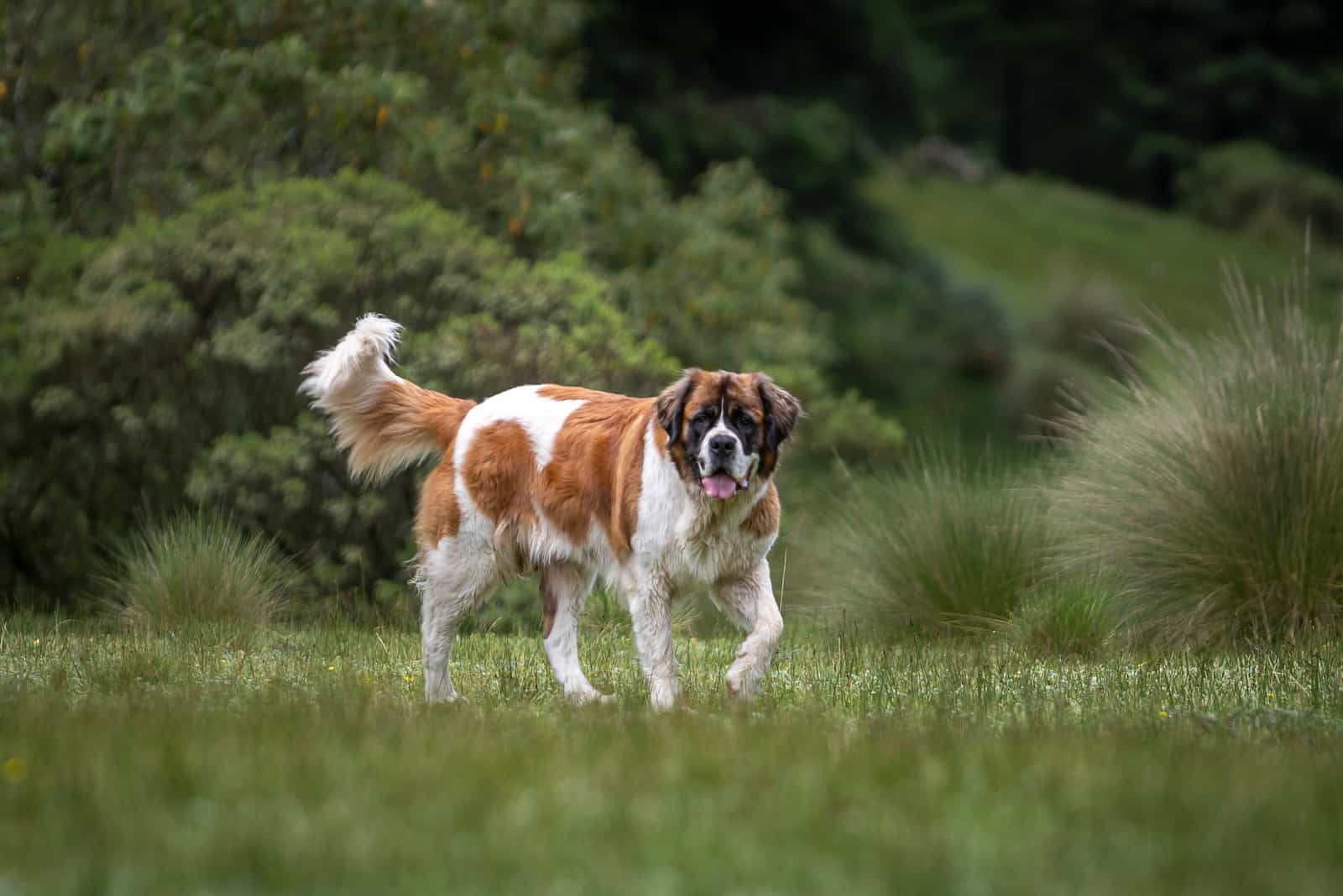
Saint Bernards usually reach their adult size at 24 months of age.
Just like every other mammal, an adult male Saint Bernard is larger than an adult female Saint Bernard.
An adult female Saint Bernard dogs’ height ranges between 25 and 27 inches. Females usually weigh from 120 to 140 pounds.
Standing 28 inches tall, adult male Saint Bernard dogs weigh up to 185 pounds!
So, to find the middle ground, a healthy grown-up Saint Bernard dog will stand anywhere from 25.5 to 27.5 inches tall, and weigh between 130 and 180 pounds.
What Age Do Saint Bernards Stop Growing?
It seems like this large dog keeps growing, and growing. It has been more than a year, and you are wondering, “When will my Saint Bernard stop growing?”
Well, when mother nature decides to. A Saint Bernard puppy will stop growing when it reaches two years of age.
But, in some cases, St. Bernard dogs stop growing when they reach their third birthday.
This might seem like a long time, but giant breeds usually reach adulthood slower than small dogs. Maybe that’s why people call them big babies!
Reaching adulthood is not necessarily in sync with reaching sexual maturity.
Saint Bernard dogs reach sexual maturity between ten and 18 months of age. This means that they are still in their growing-up phase when reaching sexual maturity.
Factors Affecting A Saint Bernard’s Growth
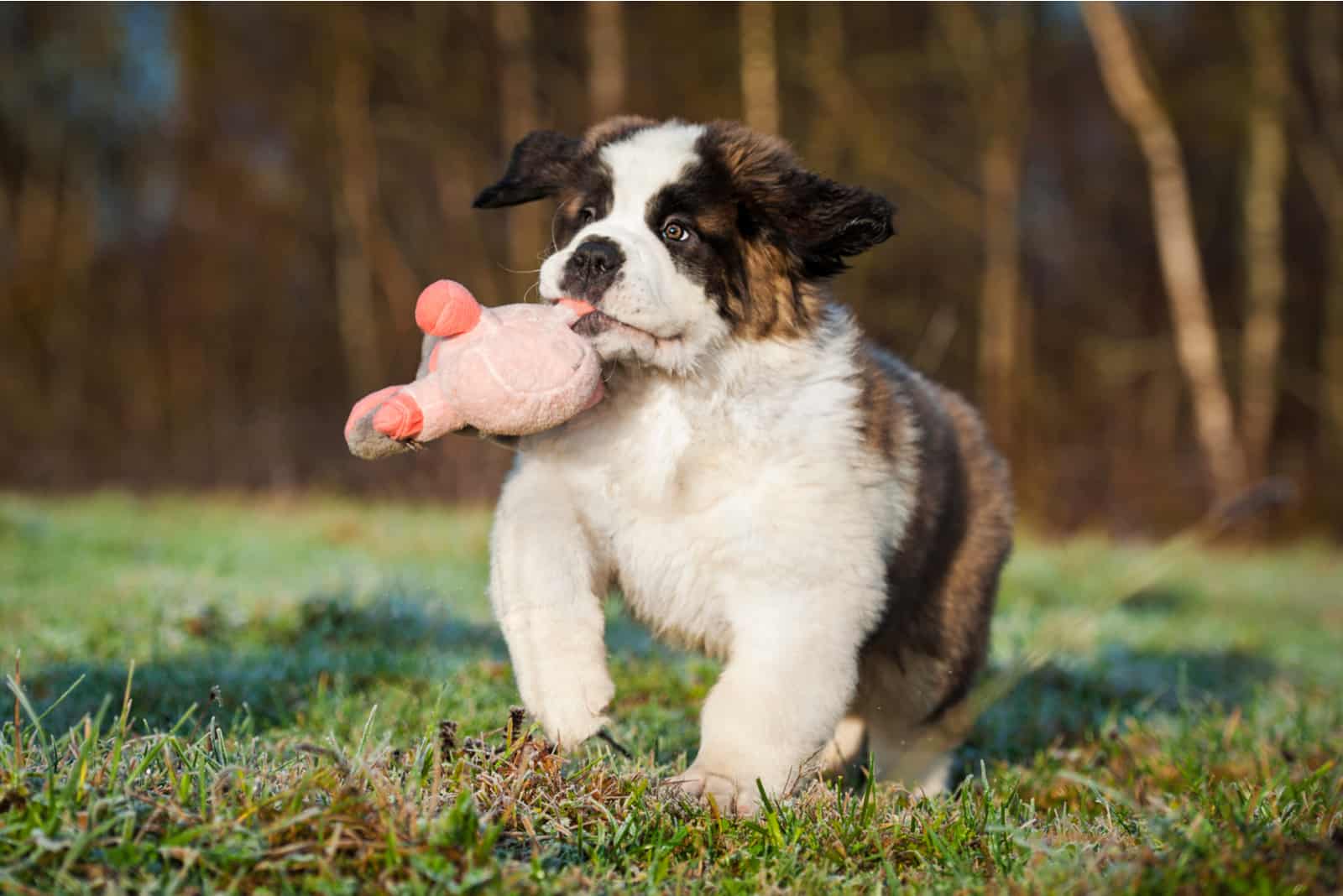
There are a few crucial factors for healthy Saint Bernard puppy growth. Each living organism requires these factors in order to grow, let alone live.
Needless to say that each of these factors is intertwined with one another. They act together to influence the growth of a healthy Saint Bernard puppy.
This means that all of the factors that we’re going to mention are equally important, and all play a huge role in your Saint Bernard’s growth chart.
Let’s learn more about the internal and external factors that affect a Saint Bernard’s growth.
Genetics
The first factor we want to talk about is genetics. This is pretty easy to understand. Every creature on this planet has its unique set of genes.
Genes regulate temperament, appearance, behavior, lifespan, and many more characteristics that make up an organism. Genes are also guilty of hereditary, breed-specific diseases, which we will get to later in this article.
Some might think that a dog’s weight is only influenced by its diet, but genetics can be the main culprit as to why your Saint Bernard is a bit chubby.
In the canine world, genetics is a huge topic because many dog breeders rely on this branch of science. So, by selecting parent breeds with strong genetic profiles, dog breeders develop favorable traits in their puppies. Most importantly, they develop healthy puppies.
Say, if a breeder were to breed two large, purebred Saint Bernard dogs, their offspring would also come out as a large dog. But, if there are some exceptions and errors in the breeding program, a Saint Bernard puppy might not come out as expected.
You will notice that many reputable Saint Bernard breeders use DNA tests to check their breeding dogs for hereditary diseases.
How genetics will affect a Saint Bernard’s growth depends on the quality of the breeding program.
To put it simply, genes are the cause of the large size in St. Bernard dogs. So, the better the genes — the better the Saint Bernards’ growth.
Environment

Environmental factors can affect a Saint Bernard’s growth in many ways. We already know that the sun plays a huge role on our bodies. So does it on our puppy’s bodies.
Having some fun in the sun is very beneficial for a Saint Bernard puppy’s growth. Puppies “feed” off of healthy sun rays, which are the main source of vitamin D.
Natural vitamin D is crucial in the normal development of bone and muscle tissues. There is no kind of supplement that can replace the natural source of this vitamin.
Alongside sun rays and natural environmental settings, there are some environmental factors that are under your control.
You might notice that puppies that have been kept in kennels and puppy mills never reach their full potential. They seem to stay small and weak even when they officially reach their adult size.
As a responsible owner, you are required to meet your Saint Bernard puppy’s needs. Due to the fact that this is a big dog, it needs a lot of space in order to run around and play.
So, if a Saint Bernard puppy isn’t kept in a suitable environment, it won’t grow up as a healthy dog. Moreover, it will not reach its full size according to the breed standards.
Proper Diet
Eat well to live well, right?
That is exactly how it should be. From the first days of life, the Saint Bernard puppy requires nutritional food. The first “food” it encounters is its mother’s milk.
And, I can’t stress enough how important it is for newborn puppies to receive their mother’s milk within the first three to four hours of life.
The first milk that mothers produce is called colostrum. This milky substance is rich in proteins, healthy fats, and most importantly — immunoglobulins.
Immunoglobulins are protectors of the puppy’s health. Once they get to the body, they act as a shield to protect Saint Bernard puppies from early diseases.
During the first year of life, the puppy’s diet will change. When transitioning to a new diet, It’s important to feed your Saint Bernard high-quality dog food.
High-quality dog food will not only make the Saint Bernard puppy grow into a big dog, but it will also help in strengthening its immune system.
It is believed that feeding your Saint Bernard puppy a raw diet after transitioning from its mother’s milk is the best way to raise a healthy Saint Bernard dog. You can find more useful information on this dog’s diet in our Saint Bernard feeding chart.
Exercise
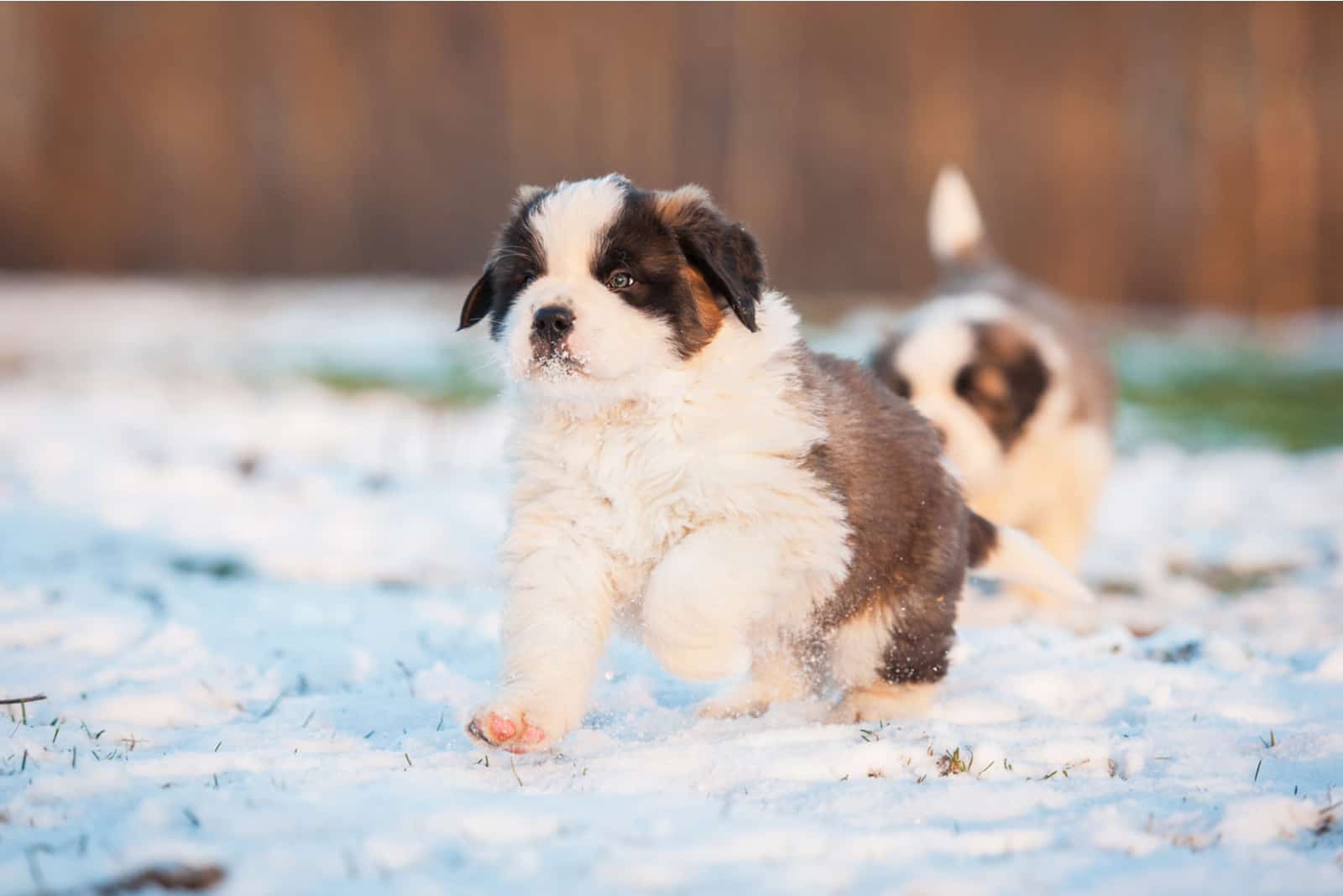
During the first months of age, regular exercise and quality playtime are among the most important factors affecting a Saint Bernard’s growth.
With regular exercise, your dog will get sun rays, fresh air, as well as muscle gain. And, we all know how important it is for young puppies to stretch their legs and build a good foundation.
Not only is a Saint Bernard’s size affected by regular exercise, but its mental state also greatly benefits from this factor.
Healthy Saint Bernard puppies that undergo early socialization and daily interaction with their human and dog friends grow up into well-mannered, outgoing big dogs.
Can Neutering/Spaying Have An Effect On A Saint Bernard’s Growth?
Dog sex hormones regulate its growth. So, spaying and neutering at a very early age might cause trouble in a Saint Bernard puppy’s development.
Spaying affects female Saint Bernard puppies by reducing their estrogen levels. With spaying, a female Saint Bernard puppy has her uterus and ovaries removed.
Since ovaries are the main source of the estrogen hormone, spaying can affect the development of secondary sex characteristics in female Saint Bernard dogs – that is, if spaying is done too early.
Spaying a female Saint Bernard is usually done between six and twelve months of age.
When it comes to male Saint Bernard puppies, neutering can affect their growth the same way that spaying affects a female puppy’s growth.
Neutering leads to a lack of the testosterone hormone in male Saint Bernard dogs. Male Saint Bernard puppies are neutered between six and nine months of age.
This surgical procedure removes a male dog’s testicles, which produce the testosterone hormone.
Without this hormone, the puppy’s growth is usually stunted in male Saint Bernard dogs.
Saint Bernard Weight Calculator – Does It Really Work?
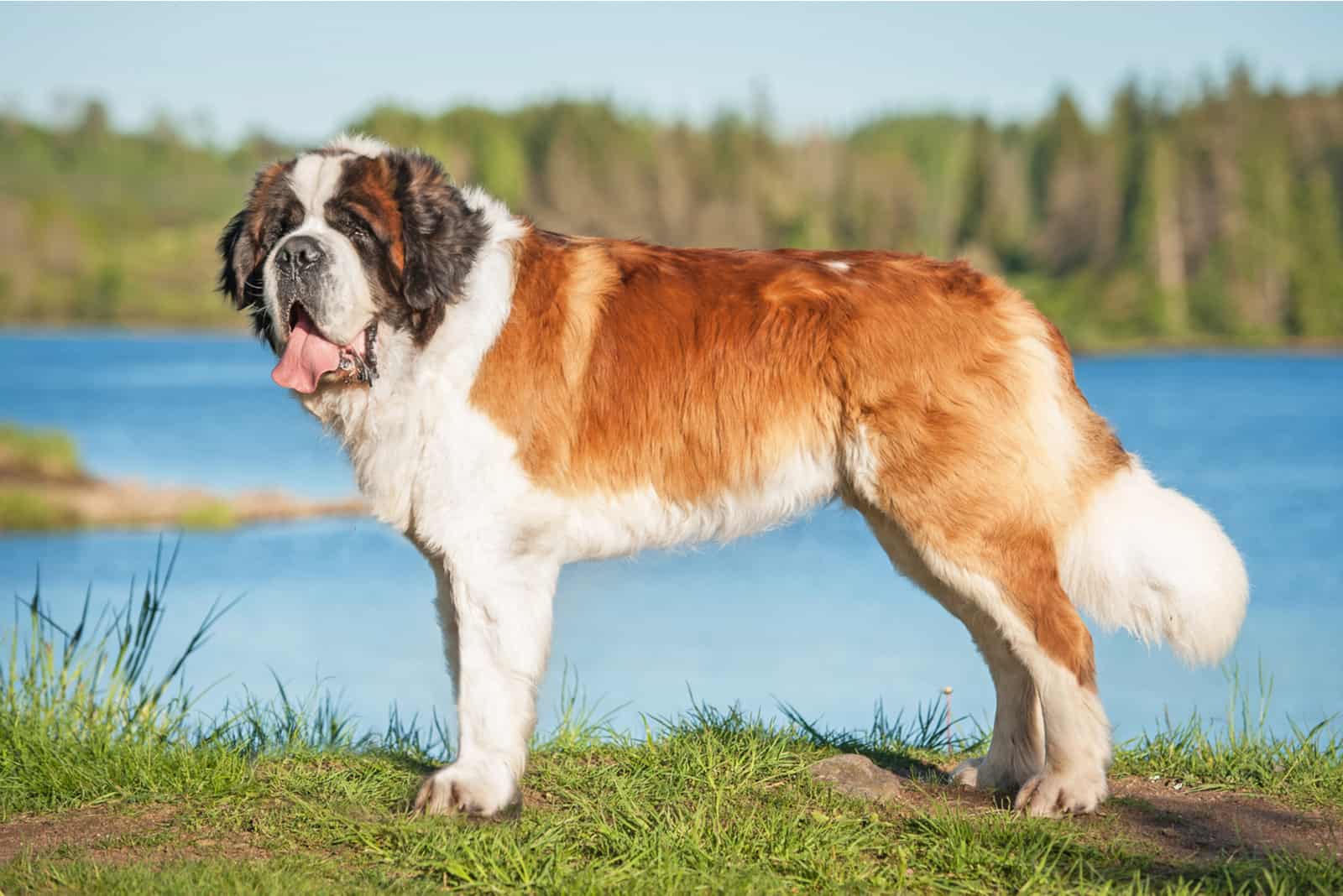
Now that you are familiar with the Saint Bernard’s growth chart, you may be wondering, “Is there a way to predict my Saint Bernard puppy’s size?” — of course, there is!
A puppy weight calculator is a great tool that you can use to estimate your Saint Bernard puppy’s growth. To use an interactive weight calculator, you simply enter your puppy’s current weight and age.
Then, the weight calculator does its magic and shows you how big your Saint Bernard puppy will grow. But, keep in mind that weight calculators aren’t always accurate. In fact, they only show an estimated puppy growth.
No one, and no program can exactly predict how big a Saint Bernard puppy will get.
But, when you consider all the factors that affect a St. Bernard’s growth, you can predict how small your dog will stay if its basic needs aren’t met.
How Big Is Too Big?
Adult Saint Bernard dogs weigh between 160 and 190 pounds with 190 pounds being the threshold in their adult weight chart.
When feeding, combined with low physical activity gets out of hand, the adult St. Bernard can gradually develop obesity.
In fact, this large breed is prone to obesity. Saint Bernards usually don’t like to move around as much as small dogs do. Most of them even prefer laying on the couch or napping in the back yard.
But, excessive laziness can actually lead to health problems.
Mind you, it’s not all the dog’s fault. If you have a bad habit of feeding your St. Bernard one too many snacks or table scraps, it will grow bigger and chubbier up to the point where obesity takes its toll on the dog’s overall health.
Saint Bernard Health Issues

Unfortunately, the Saint Bernard is one of those purebred dogs that inherits a variety of health problems. Usually, these Mastiff-type dogs suffer from joint dysplasia and eye problems.
Hip and elbow dysplasia are common problems in all big-dog breeds. Due to the fact that our St. Bernard is a very large dog, joint dislocations are bound to occur in adulthood.
When you look at the anatomy of the St. Bernard’s head, you notice that the skin on its head drops downwards. Such hanging skin folds can cause eye problems because the weight of the skin exposes the eyelid’s mucosa.
Other than that, a Saint Bernard’s health is affected by diet, environmental factors, genetics, physical activity, and irregular veterinary checkups.
Age-appropriate immunization plays an important role in a Saint Bernard growth. The first vaccinations that a St. Bernard puppy receives are crucial in fighting puppy diseases.
Deworming treatments are also a must. Intestinal parasites in young St. Bernard puppies can lead to underdevelopment and gastrointestinal problems.
Here is a list of breed-specific health problems you should look out for in your Saint Bernard puppy:
• Hip dysplasia
• Entropion
• Elbow dysplasia
• Diabetes
• Obesity
• Heart conditions
• Bloat
Saint Bernard health issues can develop as early as in the first year of life.
But, many health problems can appear later in life. Some Saint Bernards are lucky enough to never experience any health issue during their lifetime.
Saint Bernard Life Expectancy

Saint Bernards are giant dogs — and giant dogs have shorter lifespans. Not only do these big dogs grow fast, but they age fast, too.
It’s not easy being big!
A lot of health concerns are linked to the St. Bernard’s large size. Due to the fact that this is not the healthiest breed of dog, its life expectancy is shorter than in other dog breeds.
A Saint Bernard’s life span ranges between seven and twelve years. Their life expectancy is greatly influenced by growth factors and care provided by their owner.
Maintaining a healthy lifestyle will have a positive effect on a St. Bernard’s longevity.
Reputable St. Bernard owners and breeders regularly visit their veterinarian, making sure that their big dog is all well and good!
Saint Bernard Fun Facts
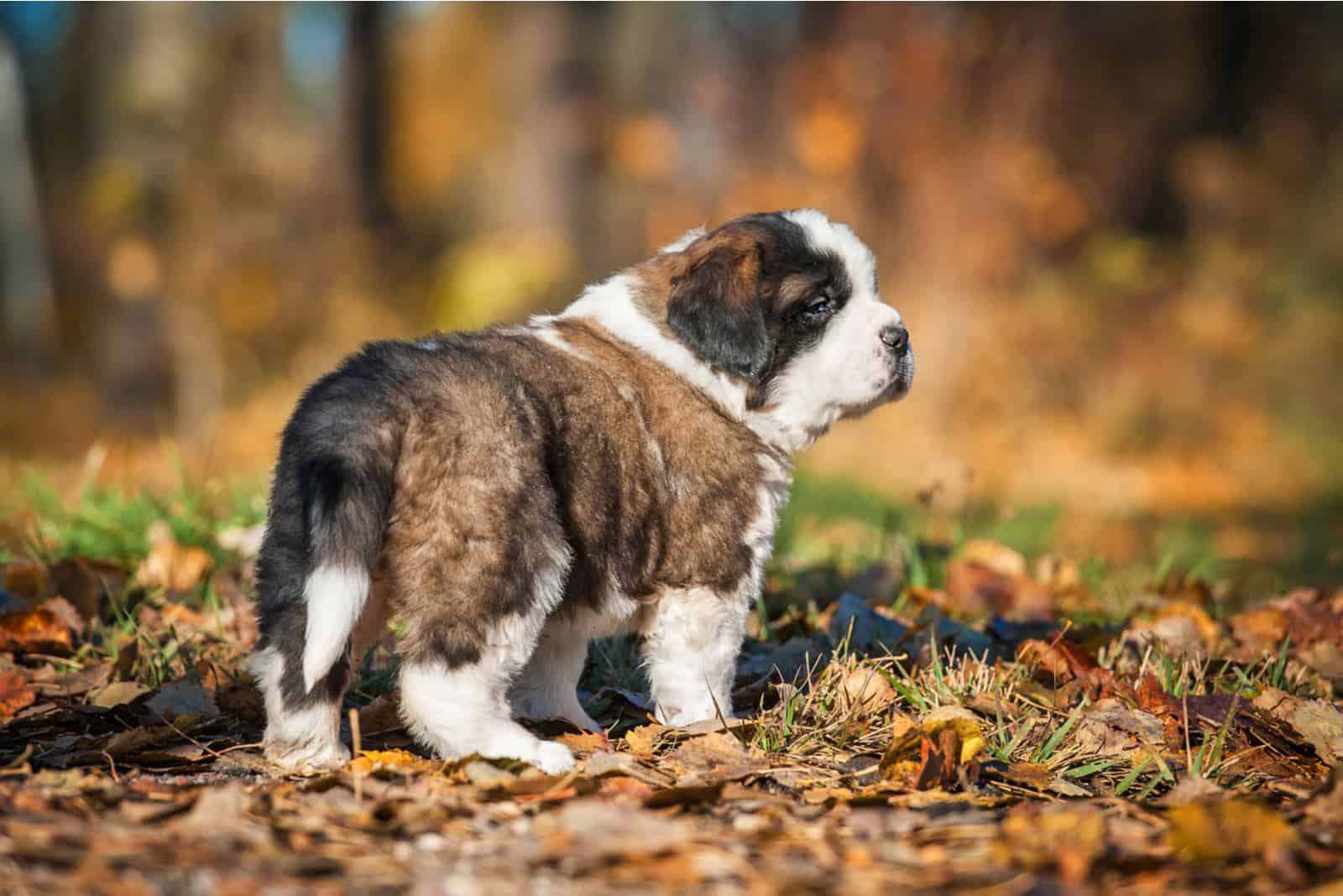
The Saint Bernard is such a fascinating breed of dog. This incredible pooch has been featured in many movies and cartoons.
There might be some Saint Bernard facts you still haven’t heard of. Here are some interesting ones:
• St. Bernards are not the smartest dogs around. In fact, these dogs are ranked below average in terms of intelligence. Although they make good watchdogs and are relatively easy to train, St. Bernards don’t seem to bother learning but a few tricks and commands.
• The Saint Bernard falls under the Mastiff-type dog category. But, this big dog is not your average Mastiff. The St Bernard is known as the “Alpine Mastiff”. And, as the name implies, this large dog originates from the Alps in Western Switzerland.
• Barry is the most famous St. Bernard dog in the world. This amazing dog has rescued over 40 people in the Swiss mountains. He became a canine legend, and even got his own statue!
• The “Saint” in the Saint Bernard’s name doesn’t actually refer to a saint. St. Bernard is a popular (and very dangerous) passage in the Alps between Switzerland and Italy. St. Bernard dogs showed great courage in helping their humans pass through it.
• St. Bernards never really carried small barrels around their neck. Even though we have seen it on TV, a St. Bernard has never worn this kind of collar. Rescue St. Bernard dogs do carry packs of food and first-aid, though. Besides, carrying a barrel around the neck is a safety hazard.
• A true gentle giant — the Saint Bernard is the most affectionate big dog you will meet! They are known to be extremely good with children and other animals. With a laid-back temperament, a Saint Bernard almost never causes any ruckus.
• Benedictine is the name of the largest Saint Bernard dog. Weighing a whopping 357 pounds, this big dog holds the world record of being the heaviest canine in the world.
• A Saint Bernard’s coat is double-layered. These dogs can inherit short and long coats. You’ll be surprised to know that the Saint Bernard comes in more than ten different coat colors!
To Sum It Up

Photo from: @saintbernardkingdom
Whether you’re looking at St. Bernard puppies or adults, there is no doubt that these pooches are some of the most adorable dogs in the world!
Its big size, along with a soft, long coat makes the Saint Bernard a great cuddle companion. What people love the most about the St. Bernard dog breed is how gentle and peaceful they are.
Estimating the weight and growth of your St. Bernard puppy can be tricky to do by yourself. What this St. Bernard growth chart gives you is a picture of how big your St. Bernard will get in certain periods of its development.
So, estimating its size will be a lot easier with this puppy growth and weight chart.
If you have just gotten a St. Bernard puppy, or if you are planning to get one, you will find this Saint Bernard growth chart very useful.
But, keep in mind that these numbers are not 100% exact. Each St. Bernard puppy is unique — some are born bigger, some smaller, but they all grow up to be the biggest snuggle buddies!
Read Next:
• Top 5 Most Reputable Saint Bernard Breeders In Ontario
• Mini St. Bernard: 14 Reasons To Own Or Not Own It
